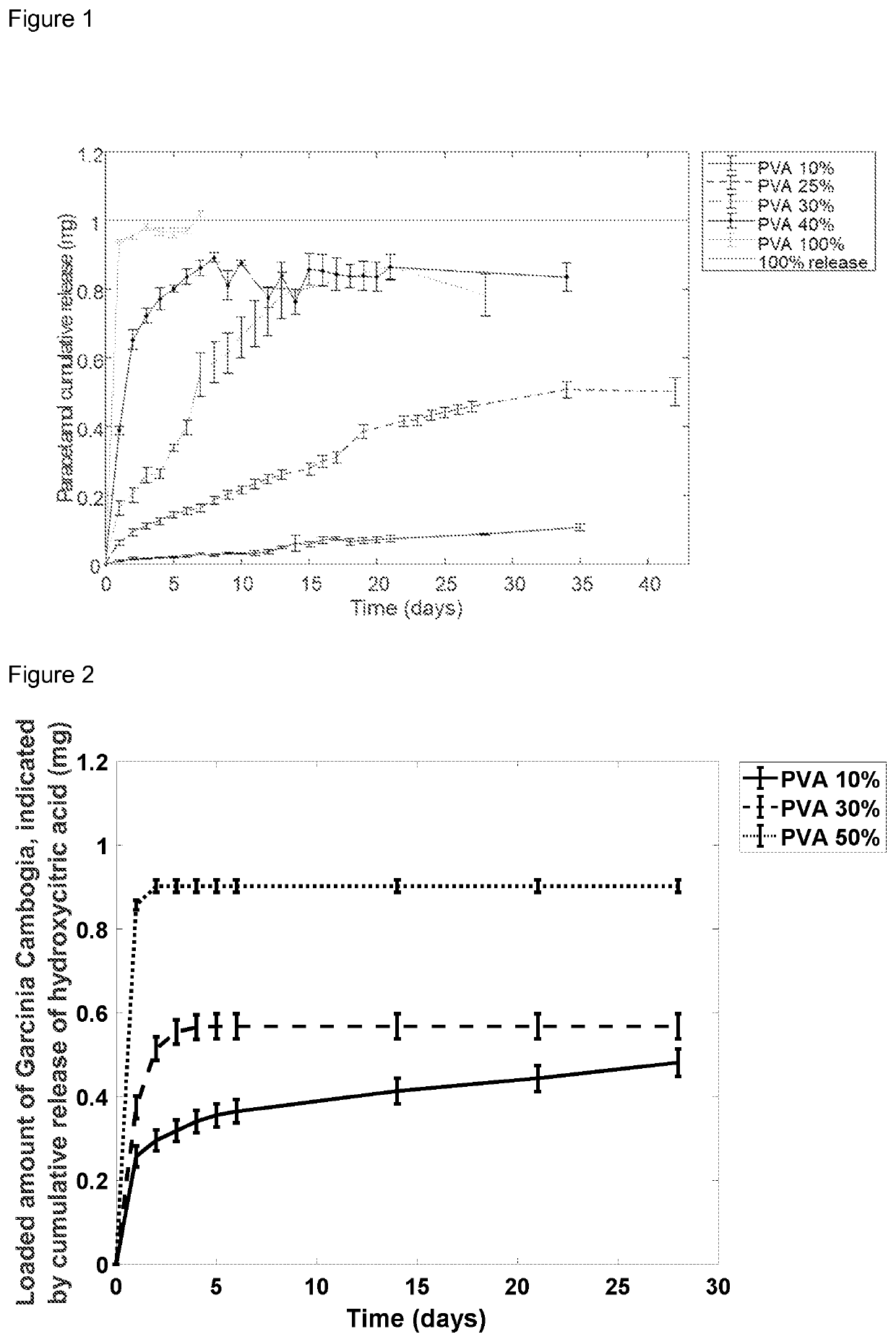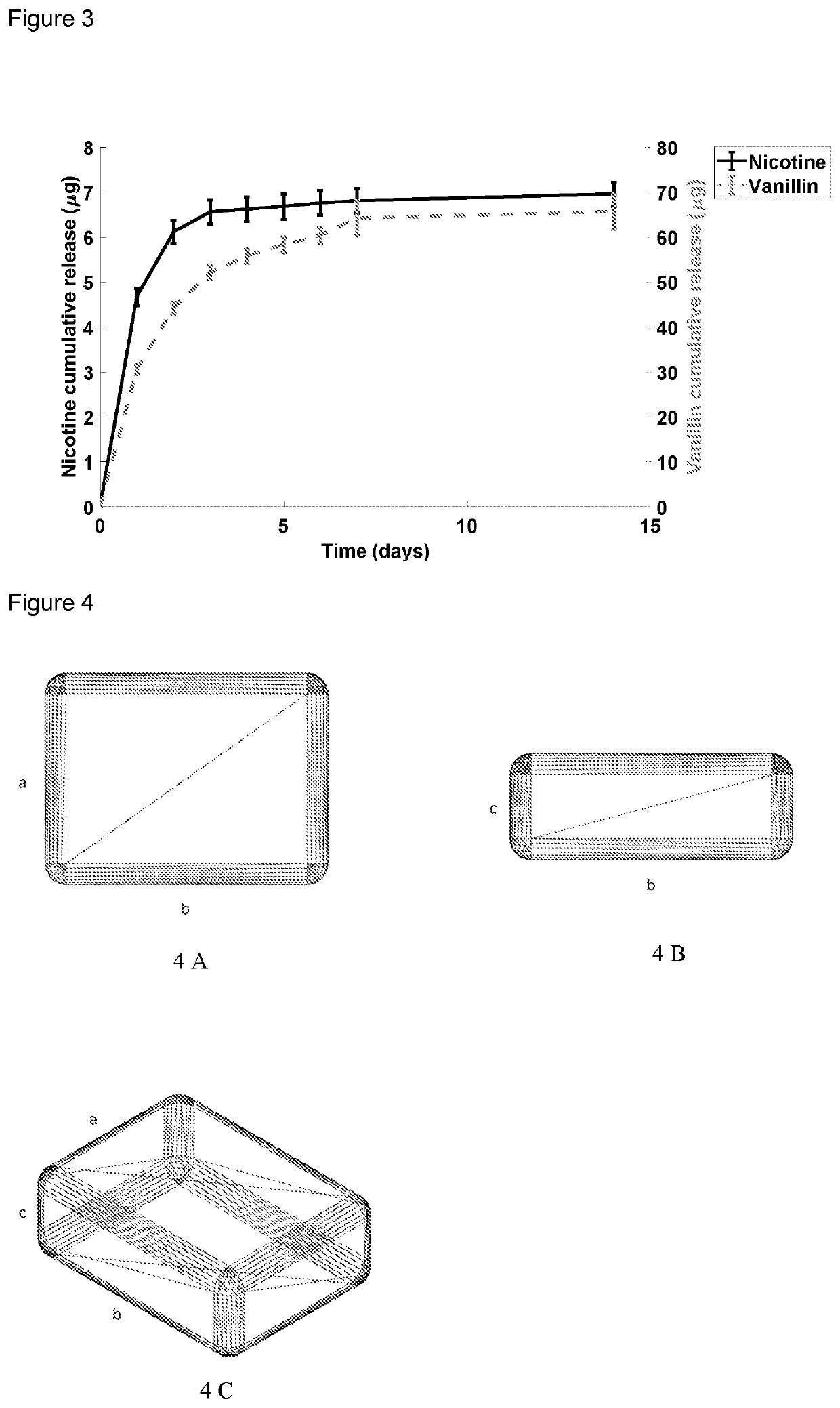Controlled release device for oral cavity
a technology of controlled release and oral cavity, which is applied in the direction of tooth capping, dental surgery, drug compositions, etc., can solve the problems of drug delivery device detachment, user burden of wearing such a device, and inability to control the local release of active agents, so as to improve the release of active agents
- Summary
- Abstract
- Description
- Claims
- Application Information
AI Technical Summary
Benefits of technology
Problems solved by technology
Method used
Image
Examples
example 1
[0066]1.5 g of acetaminophen (paracetamol) was placed in a flask. 1 mL of water was evenly spread among the acetaminophen powder to moisten it. Then, a mixture of poly(lactide) (PLA) and poly(vinyl alcohol) (PVA) weighing 30 g in total was mixed with the moist drug powder. The amount of PVA was varied in the various mixtures accordingly; PVA 10 w-%, PVA 25 w-%, PVA 30 w-%, PVA 40 w-% and PVA 100 w-%, the balance being PLA. The mixture was stirred until all the drug has adhered on the surface of the polymer pellets. Then, the mixture was put into an oven at 40° C. to dry for 6 hours. Afterwards, the dried mixture was poured into the filament extruder operating at 170° C., which produced a filament with a thickness of 1.75±0.03 mm. The filament was fed to a 3D-printer operating at the nozzle temperature of 175° C. and nozzle diameter of 1.75 mm. The printer used a raster pattern to fabricate the devices layer-by-layer.
[0067]Each device or polymer-paracetamol formulation weighted 20 mg...
example 2
[0070]3 g of Garcinia Cambogia herbal extract (Golden Horizon Biologics, the extract is based on an extraction of the fruit grind), comprising 60 w-% of hydroxycitric acid (HCA), was mixed with three different polymer matrices of PLA and PVA, each of the polymer matrices weighing in total 50 g, wherein the first one composed of 50 w-% of PVA, the second 30 w-% of PVA, and the third 10 w-% PVA, the balance being PLA. The 60 w-% content of HCA in the Garcinia Cambogia herbal extract was not verified. Thus the results are given in HCA released from an indicated amount of Garcinia Cambogia herbal extract loaded in a device. The subsequent fabrication procedure follows that of Example 1.
[0071]Each device weighed ca. 20 mg with estimated Garcinia Cambogia herbal extract content of 1.1 mg. Drug release experiments were performed to evaluate the loaded amount of Garcinia Cambogia herbal extract. This evaluation was done by measuring the released HCA, which directly gives the amount of Garci...
example 3
[0073]45 g of microcrystalline cellulose powder (50M, size) was placed into a flask. 40 mL of liquid nicotine was added into the flask to soak it into the cellulose. 15 g of vanillin was then mixed into the flask to conceal the odor of nicotine. Then, 20 g of PLA and 20 g of PVA were added into the flask to produce a polymer matrix formulation containing 50 w-% of PVA. Afterwards, the procedures are similar to Example 1.
[0074]Each device and formulation weighed ca. 20 mg, as in the previous examples. However, the loading degree of nicotine was 0.04 w-%, which is presumed to result from vaporization of nicotine in the filament extruder. The loading degree of vanillin was 0.32 w-%.
[0075]The release of nicotine and vanillin was measured similarly as in Examples 1 and 2. The results of the release experiments are shown in FIG. 3. Nicotine was released fast reaching 6 μg on day 2, after which the release slowed to result in ca. 7 μg on day 14. Vanillin reached ca. 50 μg release on day 4,...
PUM
| Property | Measurement | Unit |
|---|---|---|
| solubility | aaaaa | aaaaa |
| solubility | aaaaa | aaaaa |
| temperatures | aaaaa | aaaaa |
Abstract
Description
Claims
Application Information
 Login to View More
Login to View More - R&D
- Intellectual Property
- Life Sciences
- Materials
- Tech Scout
- Unparalleled Data Quality
- Higher Quality Content
- 60% Fewer Hallucinations
Browse by: Latest US Patents, China's latest patents, Technical Efficacy Thesaurus, Application Domain, Technology Topic, Popular Technical Reports.
© 2025 PatSnap. All rights reserved.Legal|Privacy policy|Modern Slavery Act Transparency Statement|Sitemap|About US| Contact US: help@patsnap.com


